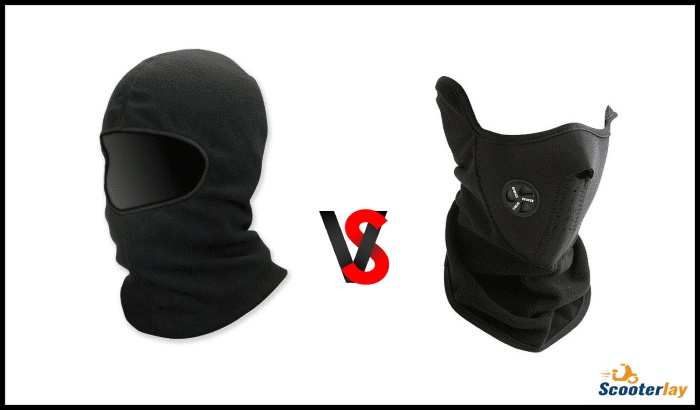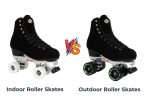You want to go for snowboarding or wish to ride a snowmobile, but you’re afraid of the harsh weather conditions. There’s no need to worry about such a possibility any longer! Like other essential gear such as snowboarding gloves and warm clothes, Balaclava, ski masks will make you fearless with their warmth and safety.
Both are great for you, but they have numerous differences. We’ll make it clear for you here.
Balaclava vs Ski Mask – What You Need to Know

Balaclava
Balaclava is a kind of headwear that offers protection against cold weather. It covers your head, ears, neck, and face, leaving space for eyes, mouth, and nose. This headgear is used for warmth, safety, and sometimes camouflaging.
These masks come in different shapes; some of them are just exposing eyes, some eyes, and mouth, and some even expose the whole front face. These masks usually work as a ski helmet, and sometimes under the helmet.
- Advantages
Balaclava is very useful for a lot of occasions. These masks made of different materials as per your needs, e.g. wool, microfiber polyester, nylon, polypropylene, polar fleece, and others.
The wool mask offers warmth, easily breathable, and regulates body temperature. The microfiber polyester mask offers moisture-free skin and keeps you extra warm. The nylon and polypropylene layers repel liquid and keep your skin dry inside. These are the best for skiing, snowboarding, and mountain climbing.
- Disadvantages
There are no disadvantages to the balaclava. So, just pick the right material according to the weather conditions, and you’re good to go. If you don’t use the right material, then you might face inconvenience.
They can’t resist the harsh wind noise, so use earplugs while skiing or riding a snowmobile. Although, be careful about the earplugs. Sometimes they block out all the sound and you may not hear any vehicle approaching.
Ski Masks
A ski mask is also a kind of headwear, protecting you from cold weather. Almost the same as a balaclava, it covers the ears, head, neck, and has a necessary hole when covering the face.
Ski masks are mainly used for skiing, and their material also follows the skiing pattern, providing warmth, safety, and the ability to breathe in.
Mostly, these masks are used under ski helmets. But balaclava and ski masks are so similar that you can use them interchangeably.
- Advantages
Ski masks are no different than the balaclava; they are almost the same and have the same advantages. They’re made of different materials, and different weather conditions determine their materials.
They’re basically used for snowboarding and riding a snowmobile. These masks are great for breathing and do not fog your ski glasses.
You can also roll them up to the crown to make a hat and roll down and wrap against the neck.
- Disadvantages
There are some loose ends of ski masks too. Like balaclava, ski masks are commonly used under the helmet, so another vehicle approaching won’t cross your ear with all the wind noise, when skiing.
You must consider using earplugs, like balaclava to avoid excessive noise in your ears while skiing. However, sometimes, these masks affect the earplugs too, blocking all sounds.
How do you measure your head for a balaclava?
- Use a measuring tape to measure around your head.
- Make sure the tape passes across the middle of the forehead, over the ear, and over the regular bump at the back of the head
- Take 1cm extra if you have long or thick hair.
Ski Mask vs Balaclava – Who’s the Winner?
Ski mask and balaclava are two similar headgear commonly used for skiing. These masks are used under the helmet to give protection against the cold weather and winds. They have different versions; some have just a hole for eyes while some cover the mouth and nose.
Ski mask and balaclava are knitted with different materials like wool, silk, cotton, fleece, and others. Sometimes, they use two layers of different materials to make them more effective.
Ski masks are mostly used for snowboarding and riding snowmobiles, while balaclava is also used by military and police for warmth in cold places and also for hiding their faces.
Happy Skiing!
FAQs
1. Is a balaclava illegal?
Ans. Some countries have an anti-mask law. In those places, you’re not allowed to conceal your face with a balaclava or any other thing. Although, if you’re wearing it in a way that reveals your identity, it’s not a problem.
2. Do skiers wear ski masks?
Ans. It actually depends on the weather conditions. In extremely cold areas, skiers don’t ever forget their ski masks. Other than that, they use a simple face mask that covers up to the nose.
3. Why do Special Forces wear balaclavas?
Ans. Special Forces wear balaclavas for a number of reasons:
- to leave a dreadful impression on the enemy
- to help them camouflage their appearance when in dark or in the fields.
4. What material is best for balaclava?
Ans: Polyester is perhaps the best material for drying moisture away from the skin when your head is sweating while at the same time skiing. Among all materials, neoprene gives the most elevated level of warmth and wind resistance.
5. What size balaclava should I get?
Ans:
| Size | Product Circumference | Approximate Age |
| XSmall | 13-15.5” / 33-39cm | Baby |
| Small | 15.5-18” / 39-46cm | Baby / Toddler |
| Medium | 18-21” / 46-53cm | Child |
| Large | 20-24” / 51-61cm | Youth / Adult |
| XL | 21.5-26.5” / 54.5-67cm | Adult |
Note:
- Depends on Head size. Approximate age is only provided
- Item Measurements are unstretched – extended serenely









Leave a Comment